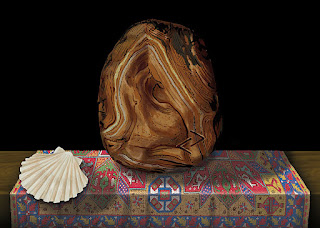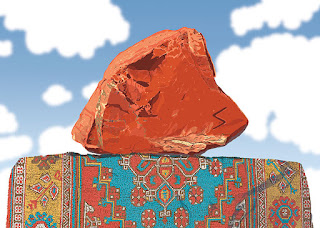Alessia Delvecchio
"Topaz”,
digital painting print on gatorfoam
(1/50) 100x140x2cm, 2023
In "Topaz", la cui traduzione è Topazio, viene rappresentato il minerale in primo piano con incisa la runa Perth la cui capacità è di rigenerazione e di donare entusiasmo. Il Topazio è indicato come nona pietra di fondazione delle mura della Città Santa nell’apocalisse di Giovanni e indica l’apostolo Pietro. La pietra poggia sopra un tappeto pandaghi del XIX secolo, della Georgia. Il tappeto è un omaggio al divino e per sua natura crea un’atmosfera mistica, ad ogni nodo intrecciato è legato il pensiero di chi lo ha lavorato dedicandovi ore della propria vita. Su di un tappeto persiano è stato scritto: “Hanno filato la sua trama col filo dell’anima”.
Gli attributi di Pietro sono la barca che indica il suo lavoro di pescatore. Le due chiavi del paradiso appese, una d’oro e l’altra in argento, hanno il potere di legare e sciogliere i legami tra cielo e terra. Il gallo simboleggia il suo rinnegamento a Cristo per tre volte. Questo lavoro appartiene alla serie intitolata "Way back into Soul", in cui sono rappresentati antichi miti in chiave moderna.
In “Topaz", the mineral is represented in the foreground engraved with the Perth rune, it has the ability is for regeneration and to give enthusiasm. Topaz is indicated as the ninth foundation stone of the walls of the Holy City in the apocalypse of John and indicates the apostle Peter. The stone rests on a 19th-century pandaghi carpet from Georgia. The carpet is a tribute to the divine and by its nature creates a mystical atmosphere, the thoughts of those who worked on it are linked to each intertwined knot, dedicating hours of their lives to it. On a Persian carpet it was written: "They spun its weft with the thread of the soul". Peter's attributes are the boat that indicates his work as a fisherman. The two hanging keys of heaven, one in gold and the other in silver, have the power to bind and untie the ties between heaven and earth. The rooster symbolizes his denial to Christ three times. This work belongs to a series entitled "Way back into Soul", in which ancient myths are represented in a modern way.











